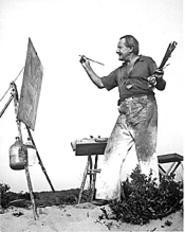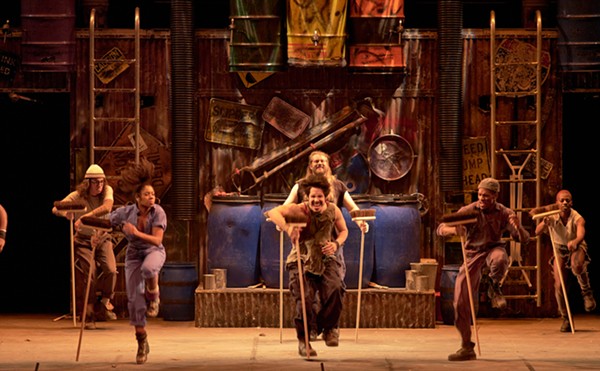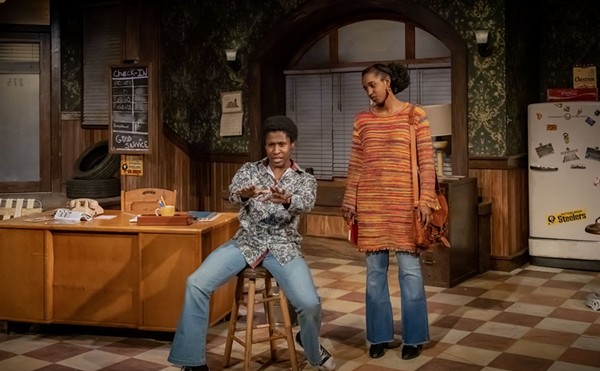
Hofmann's school was a wellspring of ideas for Abstract Expressionism, the 1950s bad-boy movement starring Pollock that shifted the capital of the art world from Paris to New York. Not only did Hofmann show young artists a new way to paint; he taught writers how to talk about the new art. Critic Clement Greenberg, AbEx's first spokesman and Pollock's promoter, based his still-influential critical theory on Hofmann's lectures. (That's how terms like "positive and negative space" entered the popular vocabulary: Greenberg co-opted what was then called "Hofmannerisms.")
Though revered as a teacher, Hofmann struggled for recognition as a painter. Critics and curators overlooked his groundbreaking efforts, such as the drip paintings "Red Trickle" (1939) and "The Wind" (1942), and gave the credit to young Jackson. His first New York exhibition came in 1944, a dozen years after he moved to the city. But in 1958, at the age of 78, he stopped teaching, and his work blossomed into a symphony of color until his death interrupted the efflorescence in 1966. Twenty-four of these post-retirement works, among the most vibrant and optimistic paintings of the 20th century, are now on view at the Akron Art Museum's Hans Hofmann: Selections From the Berkeley Art Museum Collection. These big, abstract works (many the height of a person) sing and dance with infectious joie de vivre.
Tagged as AbEx, Hoffman's style is really a synthesis of modern art's revolutionary "isms." Born in Germany in 1880, he went to Paris in 1904, where he spent a decade hobnobbing with "the Boys" -- Picasso, Matisse, Braque, and Robert Delaunay. There he digested Pointillism, Cubism, Fauvism, and Orphism, later distilling them into an art theory. He returned home to Munich before WWI and opened his first art school, which began as a therapeutic program for shell-shocked soldiers.
By this time, he'd also studied the art and writings of abstract painter Wassily Kandinsky, whose 1912 essay "On the Spiritual in Art" claimed that real art expresses inner feelings, not illusory images of the material world. Hofmann's school began attracting American art students, who bragged him up back home; during the summers of 1930 and 1931, he was invited to teach at the University of California at Berkeley.
Meanwhile, Nazism menaced Germany, and Hitler began to cleanse German museums of so-called "degenerate" art. "Anybody who paints a sky green and pastures blue ought to be sterilized," Hitler proclaimed. Hofmann's wife easily convinced Hans to stay in the U.S., so he moved to New York and a year later opened his school in the Village. Back home, most of his early work was destroyed in Hitler's purges. "If I had not been rescued by America," he later said, "I would have lost my chance as a painter." (Hofmann became an American citizen in 1941. In 1963, he gave UC Berkeley 47 major works, including the ones in the Akron show, and cash to build a museum to house his work.)
Hofmann's 1948 essay "Search for the Real" summarizes his decades of teaching. In it, he rejected the centuries-old naturalism of Western art and dumped linear perspective and modeling, the traditional ways of faking three-dimensional space on a flat canvas. Instead, he insisted that shape and color alone should create depth. For Hofmann, color was the most important aspect of a painting, and he used it, like the Fauves, straight from the tube. The effect of a painting, he said, was created by juxtaposing intense hues to achieve "tensional relationships." Finally, under Kandinsky's spell, he said that art must express "an inner perception by which we can comprehend the essence of things." Although his ideas were old hat in Europe, they gave his American students a new way to attack painting.
He also gave them a famous theory that's still taught today. In "Morning Mist" (1958), perhaps the most famous of the 24 paintings on display in Akron, rectangles of eye-popping warm reds, yellows, and oranges (which seem to advance) and cool blues and greens (which seem to recede) induce his famous "push-pull" effect. These tensional relationships make the eye dart back and forth in space, creating the illusion that the painting is pulsating or breathing. While "Morning Mist" captures the shimmering effects of early light, the more austere and less frantic "Silent Night" (1964) indicates man-made light flickering in rural darkness. Fields of dark blue and green divide the canvas into earth and sky, while rectangles of yellow, orange, and tan the shade of Grey Poupon vie for attention on the surface.
Hofmann enhanced the push-pull in some paintings by juxtaposing colorful geometric shapes with drips and spontaneously brushed fields of paint. The large, Rorschach-like splatter of black paint in "Rope Swinger" (1962) struggles to dominate four rectangles and a circle floating on white canvas. In other paintings, the geometric shapes are gone, replaced by gestural brushwork. "Maiden Dance" (1964) is a mythic place where two opposing fields of blue wash in the lower half of a white background suggest a seascape, while dark stains above suggest clouds. Meanwhile, squiggles of darker blue paint, squirted directly from the tube onto the blue fields, squirm toward the viewer. A splatter of brown paint, just off-center, drizzles down to the horizon line. Hofmann's genius is his ability to create a unified painting from dozens of precariously balanced mini-compositions (more tensional relationships at work).
The Akron show includes a one-hour documentary about Hofmann's teaching methods, narrated by Robert De Niro, whose parents studied at the artist's school. A parade of artists talk about how Hofmann taught them new ways to view art. But Hofmann did more than teach technique. "He was a genius at drawing us out emotionally," says one artist. "He got us to experiment, to explore, and to dare."
Though Frank Stella never studied at Hofmann's school, he learned plenty from his paintings: "I see the best American painting as spinning off from the core that Hofmann created through his teachings and writings."
"You journey into each painting," offers another artist. Hofmann's works are meant to be explored. His vivid colors, gestural blobs, splatters, palette-knife scrapes, and delicate washes should be savored, not gulped. Curator Kathryn Wat placed wicker chairs in the galleries for this purpose. She's also arranged the show in thematic groupings (Nature, Wide Open Spaces, Push-Pull, The Spontaneous Gesture, and Making Music) that focus on techniques or types of image favored by Hofmann. "I am many people," he'd say, "so I paint in many styles." Whatever the style, he painted intuitively, "entering into a kind of dialogue with the painting," Wat writes.
It's hard to look at Hofmann's 24 paintings without seeing Miró's red and black organic blobs, Kandinsky's calligraphic scribbles, Mondrian's squares and rectangles, Matisse's colors, Cubism's planes, and the Fauves' globs and swirls of paint. But he managed to fuse these influences into a signature style. Hofmann described a true work of art as a living organism, a self-sufficient system with its own laws, harmony, and balance. In these late paintings, he creates the Hofmann Zone, a dimension of synthesized sensory and emotional experience that is unlike any painting before it.
"The late Picassos don't compare to the late Hofmanns," Stella says in the documentary. Maybe more exhibits like Akron's will rehabilitate the late bloomer's reputation. He deserves a place in art history textbooks as the source of Pollock's action painting and the man who helped jump-start the first "American" art movement.












